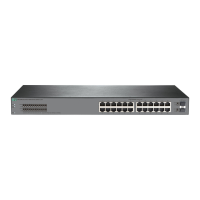33
Configuring the DHCP server
About DHCP server
A DHCP server manages a pool of IP addresses and client configuration parameters. It selects an IP
address and configuration parameters from the address pool and allocates them to a requesting
DHCP client.
DHCP address assignment mechanisms
Configure the following address assignment mechanisms as needed:
• Static address allocation—Manually bind the MAC address or ID of a client to an IP address
in a DHCP address pool. When the client requests an IP address, the DHCP server assigns the
IP address in the static binding to the client.
• Dynamic address allocation—Specify IP address ranges in a DHCP address pool. Upon
receiving a DHCP request, the DHCP server dynamically selects an IP address from the
matching IP address range in the address pool.
You can specify IP address ranges in an address pool by using either of the following methods:
• Method 1—A primary subnet being divided into multiple address ranges in an address pool
• Metho
d 2—A primary subnet and multiple secondary subnets in an address pool
A primary subnet being divided into multiple address ranges in an address pool
An address range includes a common IP address range and IP address ranges for DHCP user
classes.
Upon receiving a DHCP request, the DHCP server finds a user class matching the client and selects
an IP address in the address range of the user class for the client. A user class can include multiple
matching rules, and a client matches the user class as long as it matches any of the rules. In address
pool view, you can specify different address ranges for different user classes.
The DHCP server selects an IP address for a client by performing the following steps:
1. DHCP server compares the client against DHCP user classes in the order they are configured.
2. If the client matches a user class, the DHCP server selects an IP address from the address
range of the user class.
3. If the matching user class has no assignable addresses, the DHCP server compares the client
against the next user class. If all the matching user classes have no assignable addresses, the
DHCP server selects an IP address from the common address range.
4. If the DHCP client does not match any DHCP user class, the DHCP server selects an address
in the IP address range specified by the
address range command. If the address range has
no assignable IP addresses or it is not configured, the address allocation fails.
NOTE:
All address ranges must belong to the primary subnet. If an address range does not reside on
the primary subnet, DHCP cannot assign the addresses in the address range.
A primary subnet and multiple secondary subnets in an address pool
The DHCP server selects an IP address from the primary subnet first. If there is no assignable IP
address on the primary subnet, the DHCP server selects an IP address from secondary subnets in
the order they are configured.

